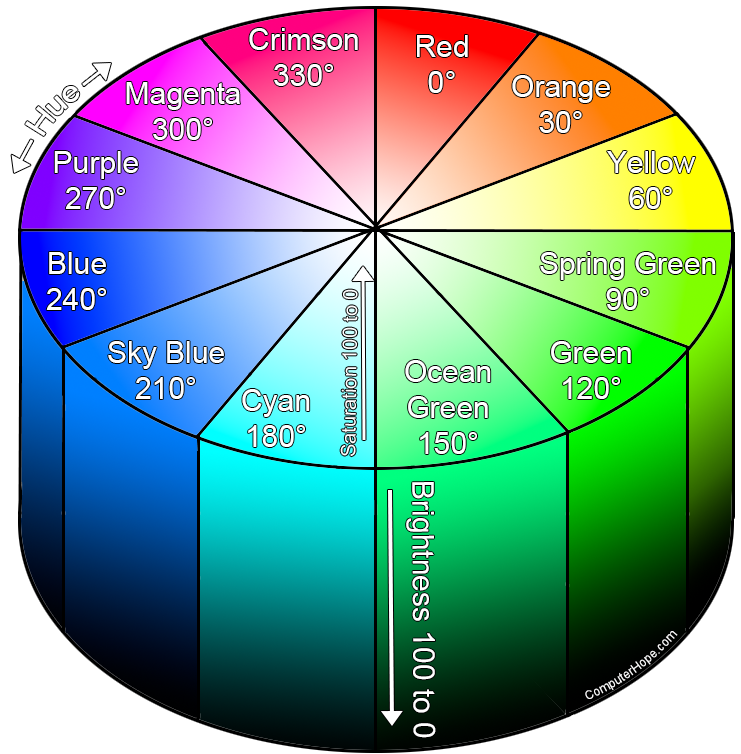Complementary color
A complementary color is the color opposite of another on a color wheel. Colors considered opposite or complementary depend on which color theory is used. However, when the two colors are mixed, they should produce a gray color if complementary.
Modern color theory includes the RGB (red-cyan, green-magenta, and blue-yellow) additive color model and the CMY subtractive color model. However, many artists still use the RYB (red-green, yellow-violet, and blue-orange) color model that dates back to the 18th century. We've listed both color wheel theories and examples on this page.
RGB complementary color examples
Below is an example of an RGB color wheel used to help illustrate HSB (hue, saturation, and brightness) and display complementary colors.

- Red <---> Cyan
- Orange <---> Sky blue
- Yellow <---> Blue
- Green Yellow <---> Purple
- Green <---> Magenta
- Ocean Green <---> Red Magenta
Each RGB complementary color is shown on Computer Hope's color code pages.
RGB split complementary color examples
The list below contains split complementary colors, which are the colors on each side of a complementary color on a color wheel. The first color listed is the key color, and the next two are the split ones.
- Red = Ocean green + Sky blue
- Orange = Cyan + Blue
- Yellow = Sky blue + Purple
- Green Yellow = Blue + Magenta
- Green = Purple + Red magenta
- Ocean Green = Magenta + Red
- Cyan = Red magenta + Orange
- Sky blue = Red + Yellow
- Blue = Orange + Green yellow
- Purple = Yellow + Green
- Magenta = Green yellow + Ocean green
- Red Magenta = Green + Cyan
RYB complementary color examples
The following list displays complementary colors according to the traditional RYB color model and color wheel.
- Red <---> Green
- Red orange <---> Blue green
- Orange <---> Blue
- Yellow orange <---> Blue violet
- Yellow <---> Violet
- Yellow green <---> Red violet
RYB split complementary color examples
The following list shows split complementary colors, which are the colors on each side of a complementary color on a color wheel. The first color listed is the key color, and the next two are the split ones.
- Red = Yellow green + Blue green
- Red orange = Green + Blue
- Orange = Blue green + Blue violet
- Yellow orange = Blue + Violet
- Yellow = Blue violet + Red violet
- Yellow green = Violet + Red
- Green = Red violet + Red orange
- Blue green = Red + Orange
- Blue = Red orange + Yellow orange
- Blue violet = Orange + Yellow
- Violet = Yellow orange + Yellow green
- Red violet = Yellow + Green
Is there a complementary color to gray?

As mentioned earlier, a complementary color is the opposite color on a color wheel. However, color wheels don't include gray. Gray is considered a neutral color made up of black and white, which contain no specific hue. On the Computer Hope color page, we list several gray colors like the picture shown here. Its complementary color is a close shade of gray unless the gray has another hue, as seen on the blue-gray color code.
See our gray color code page for an example of gray and other gray colors listed on Computer Hope.
Does black or white have a complementary color?
Black and white are achromatic, which means they have no hue and, therefore, do not appear on a color wheel. Consequently, they have no complementary color. Black and white have levels of darkness and lightness; adding white to another color lightens that color, and adding black darkens it.
